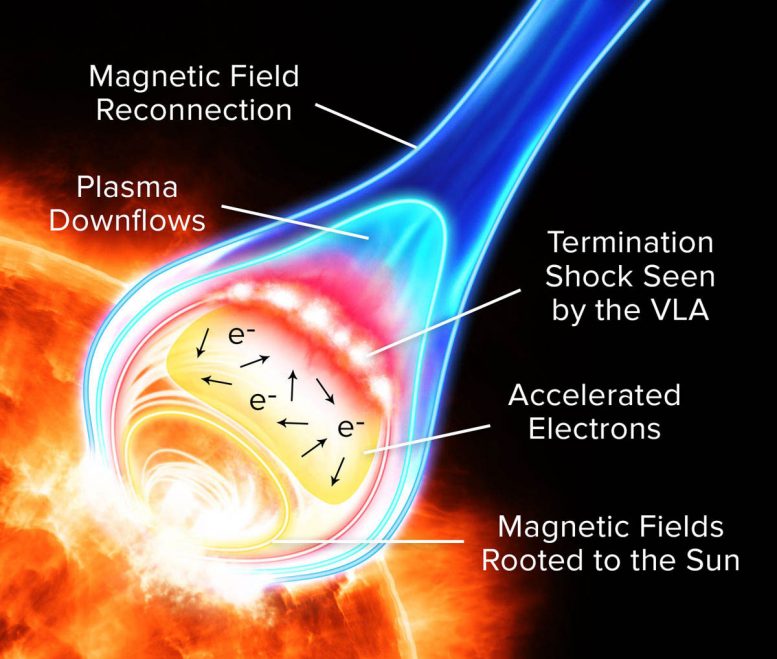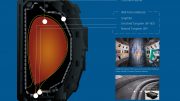Using the Karl G. Jansky Very Large Array Radio Telescope, along with other telescopes at ultraviolet and X-ray wavelengths, astronomers reveal new insights into solar flares.
Astronomers have made a significant step toward confirming a proposed explanation for how solar flares accelerate charged particles to speeds nearly that of light. This important advance was made possible by the new capabilities of the National Science Foundation’s Karl G. Jansky Very Large Array (VLA) radio telescope.
Solar flares, the most powerful explosions in the Solar System, can accelerate large numbers of charged particles like electrons and protons to nearly the speed of light. How they do that, however, has been uncertain.
“It has been thought that a specific type of shock produced by solar flares could be responsible for accelerating these particles, but there has been no convincing observational evidence for this mechanism. Now, using the raw power of the upgraded VLA, we have a fundamentally new result that strongly supports this theoretical scenario,” said the first author of the study, Bin Chen, of the Harvard-Smithsonian Center for Astrophysics (CfA).
Solar flares are often associated with powerful eruptions that throw huge amounts of material out from the Sun. Scientists think flares are produced by a sudden release of energy from solar magnetic fields. Magnetic fields in the Sun’s atmosphere are churned and tangled. An enormous amount of energy is released when those fields snap and reconfigure themselves in a process called magnetic reconnection. Researchers were unclear, though, how the energy release process could propel the high-speed charged particles that emerge from the flares.
The new VLA observations support the idea that the acceleration occurs in a region of the flare where rapidly flowing solar gases impinge on dense magnetic field loops. This creates a shock wave, similar to the sonic boom of an airplane except that it remains in one place as a so-called “termination shock.” Electrons are repeatedly pummeled by the shock into higher and higher speeds. The VLA observations of this shock closely match computer simulations that produce such a phenomenon in flares.
The scientists used the VLA, along with other telescopes at ultraviolet and X-ray wavelengths, to study a flare that erupted on 3 March 2012. The VLA can observe the Sun in a broad range of radio frequencies and in time slices of only 50 milliseconds each, producing more than 40,000 individual radio images for one second of observation. The researchers were able to determine that short-lived bursts of radio waves coming from energetic electrons were occurring where the termination shock was expected to be, according to the computer simulations performed by co-author Chengcai Shen, also a researcher at the CfA. Other details further supported the shock acceleration model.
“These new insights are a significant step forward in our understanding of particle acceleration, which is not only an important aspect of solar flares, but also a fundamental physical process occurring throughout the Universe,” Chen said.
Reference: “Particle acceleration by a solar flare termination shock” by Bin Chen, Timothy S. Bastian, Chengcai Shen, Dale E. Gary, Säm Krucker and Lindsay Glesener, 4 December 2015, Science.
DOI: 10.1126/science.aac8467










Be the first to comment on "VLA Provides New Insights into Solar Flares"